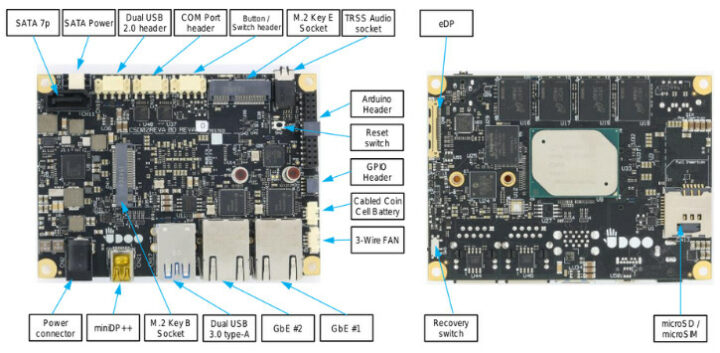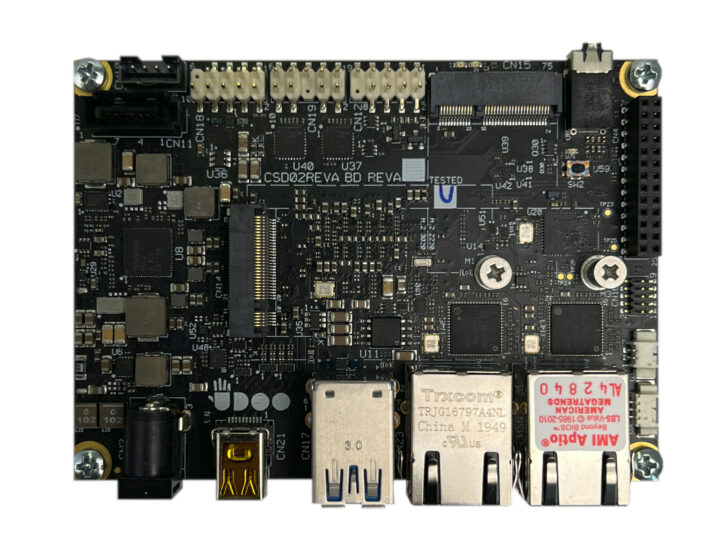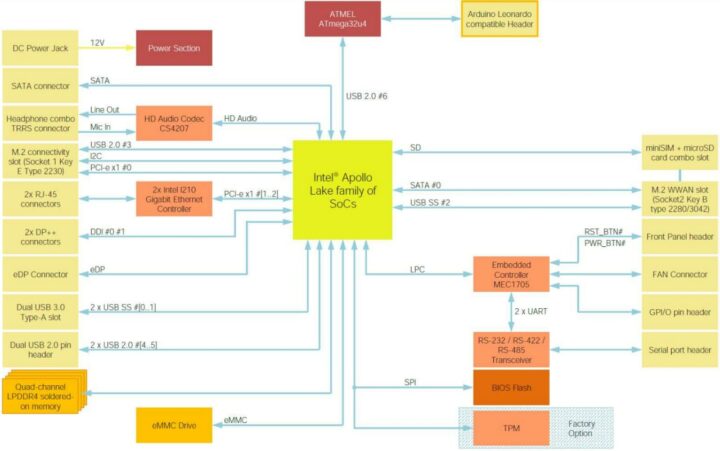UDOO VISION single board computer is powered by either an Intel Atom x5-E3940 or x7-E3950 Apollo Lake processor and features the same Microchip ATmega32U4 8-bit AVR microcontroller found in the Arduino Leonardo board to control GPIOs.
Two versions of the Pico-ITX SBC are available: the X5 with an Atom x5 processor, 4GB RAM, 32GB eMMC flash, and the X7 with an Atom x7 processor, 8GB RAM, and 64GB eMMC flash. Both come with miniDP++ and eDP vision interfaces, two Gigabit Ethernet ports, USB ports, M.2 sockets for expansion, and a 26-pin header with the same signals as in the Arduino Leonardo board.
UDOO VISION specifications:
- SoC
- UDOO VISION X5 – Intel Atom x5-E3940 quad-core Apollo Lake processor @ 1.6 / 1.8 GHz (Turbo) with 12EU Intel HD Graphics 500 series; 9.5W TDP
- UDOO VISION X7 – Intel Atom x7-E3950 quad-core Apollo Lake processor @ 1.6 / 2.0 GHz (Turbo) with 18EU Intel HD Graphics 500 series; 12W TDP
- System Memory and Storage
- UDOO VISION X5 – 4GB LPDDR4 (quad-channel) and 32GB eMMC flash
- UDOO VISION X7 – 8GB LPDDR4 (quad-channel) and 64GB eMMC flash
- Common – M.2 Key-B 2242/3042/2280 for SATA SSD module, SATA III connector, microSD card slot
- MCU – Microchip ATmega32U4 8-bit AVR microcontroller @ 16 MHz with 2.5 KB SRAM, 32 KB flash, 1 KB EEPROM
- Video interfaces
- 1x embedded DisplayPort (eDP)
- 1x Mini DisplayPort++ (miniDP++) with CEC
- Audio
- Cirrus Logic CS4207 audio codec
- Microphone and headphone combo connector (TRRS)
- Networking
- 2x Gigabit Ethernet RJ45 ports
- Optional WiFi and Bluetooth via M.2 Key-E slot
- Optional cellular connectivity via mini SIM card slot (shared with microSD) and M.2 Key B slot (type 2260/3042 modules accepted); note: it’s the same M.2 Key-B slot as in the storage section above
- USB – 2x USB 3.0 Type-A ports, dual USB 2.0 header
- Serial – RS232/RS422/RS485 UART header (COM port)
- Expansion
- 26-pin GPIO header with Arduino Leonardo I/Os
- Up to 23x digital input/output (7x PWM)
- Up to 12x analog inputs (10-bit resolution)
- 5V I/Os with a maximum of 40 mA DC current per pin.
- Support for standard Arduino R3 pinout via I/O shield
- 5-pin GPIO header
- 26-pin GPIO header with Arduino Leonardo I/Os
- Misc
- RTC coin-cell battery connector
- Bi-color Power Status LED
- Button/switch header
- IR interface
- 3-wire fan connector
- Power Supply – 12V (± 5%) DC / 3A via standard 5.5mm/2.1mm barrel jack
- Dimensions – 100×72 mm (Pico-ITX form factor)

UDOO says the VISION board supports Windows 10, 8.1, 7 64-bit, and Linux, and it’s also compatible with the Intel OpenVino toolkit for AI applications. The ATMega microcontroller is connected over USB to the Apollo Lake processor so from the user’s point of view it would be like having an Arduino Leonardo board connected to a laptop or computer. There’s detailed documentation for the board, but at the time of writing, some of it looks to be out-of-date and made for an earlier revision of the board.
The company claims the VISION SBC is “Arduino Leonardo-Compatible through the standard Arduino Pins layout and compatible with Arduino shields”. That’s somewhat true, but contrary to some of their previous boards like the UDOO X86 II that can directly take Arduino shields, you’d need to connect an I/O shield (which I couldn’t find) to be able to do the same with the UDOO VISION.
Some other interesting design choices are the miniDP++ and eDP video output interfaces, and using an M.2 Key B socket for the SSD or cellular connectivity. UDOO recommends the Transcend MTS600SATA SSD for the board. There’s a large heatsink placed underneath the board as you can see in the introduction video below.
The UDOO VISION single board computers are available now for $349 for the X5 model and $419 for the X7 model with prices excluding VAT, taxes, and shipping.

Jean-Luc started CNX Software in 2010 as a part-time endeavor, before quitting his job as a software engineering manager, and starting to write daily news, and reviews full time later in 2011.
Support CNX Software! Donate via cryptocurrencies, become a Patron on Patreon, or purchase goods on Amazon or Aliexpress








Can anyone tell me the use case for these atom+mcu boards? Seems pretty useless for most cases i can find..
Single power supply. No cables to mess with to connect between your development platform (IDE) and your development target. Using the Atom for “heavy lifting” processing while using the arduino for interfacing to sensors. Not having to reinvent the wheel for normal interfaces. To paraphrase: “Why does that cook have more than one knife and one frying pan in their kitchen? Seems pretty useless for most cases I can find…”
Or just use Linux or Arm with pins directly connected to the application processor?
It can be useful for robotics with the Atom processor taking care of applications like computer vision, and the Arduino compatible MCU handling real-time tasks such as motor control. It’s more compact than a two boards solution.
Or just use an arm-Linux platform? Cheaper and simpler to design. There are many application processors (cortex A-series) with extra r/m-cores for real-time
The short answer is that the MCU takes care of the real-time tasks. There are many use case in automotive, aerospace, medical, manufacturing industries and various robots.
But you can’t use atmega 328 in automative, aerospace, medical or industrial.. so I guess robots then, but it’s too weak for anything fancy..
These UDOO boards are with ATmega32U4, not 328.
It’s just to offer a single board solution for x86 with GPIOs and peripherals. If they were serious about it being an actual co-processor, they would have put a more serious MCU which would have costed a couple of bucks at most anyway.
If it had then it could offload quite a lot from the x86 CPU.
It’s just to offer a single board solution for x86 with GPIOs and peripherals. If they were serious about it being an actual co-processor, they would have put a more serious MCU which would have costed a couple of bucks at most anyway.
If it had then it could offload quite a lot from the x86 CPU.